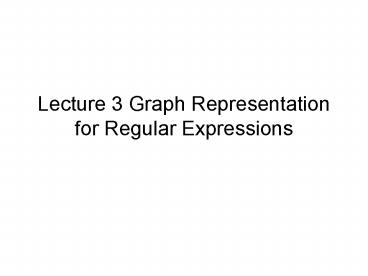Lecture 3 Graph Representation for Regular Expressions - PowerPoint PPT Presentation
1 / 26
Title:
Lecture 3 Graph Representation for Regular Expressions
Description:
A graph representation of a regular expression r is a string-labeled graph with ... The transition diagram of a DFA is an alternative way to represent the DFA. ... – PowerPoint PPT presentation
Number of Views:92
Avg rating:3.0/5.0
Title: Lecture 3 Graph Representation for Regular Expressions
1
Lecture 3 Graph Representation for Regular
Expressions
2
digraph (directed graph)
- A digraph is a pair of sets (V, E) such that
- each element of E is an ordered pair of
elements in V. - A path is an alternative sequence of vertices and
edges such that all edges are in the same
direction.
3
string-labeled digraph
- A string-labeled digraph is a digraph in which
each edge is labeled by a string. - In a string-labeled digraph, every path is
associated with a string which is obtained by
concatenating all strings on the path. - This string is called the label of the path.
4
G(r)
- For each regular expression r, we can construct a
digraph G(r) with edges labeled by symbols and e
as follows. - If rF, then
- If r?F, then
5
(No Transcript)
6
F
e
e
7
(No Transcript)
8
Theorem 1
- G(r) has a property that a string x belongs to r
if and only if x is the label of a path from the
initial vertex to the final vertex. - Proof is done by induction on r.
9
Graph Representation
- A graph representation of a regular expression r
is a string-labeled graph with an initial vertex
s and a final vertex f such that a string x
belongs to r if and only if x is associated with
a path from s to f.
10
Corollary 2
- For any regular expression r, there exists a
string-labeled digraph with two special vertices,
a initial vertex s and a final vertex f, such
that a string x belongs to r if and only if x is
associated with a path from s to f.
11
- Puzzle If a regular expression r contains u
- ''s, v ''s, and w ''s, how many
- e-edges does G(r) contain?
- Question How to reduce the number of
- e-edges?
12
Theorem 3
- An e-edge (u,v) in G(r) which is a unique
out-edge from a nonfinal vertex u or a unique
in-edge to a noninitial vertex v can be shrunk to
a single vertex. (If one of u and v is the
initial vertex or the final vertex, so is the
resulting vertex.) - Remark Shrinking should be done one by one.
13
(No Transcript)
14
(No Transcript)
15
Lecture 4 Deterministic Finite Automata (DFA)
16
DFA
17
e
p
h
b
t
a
l
a
- The tape is divided into finitely many cells.
Each cell contains a symbol in an alphabet S.
18
a
- The head scans at a cell on the tape and can read
a symbol on the cell. In each move, the head can
move to the right cell.
19
- The finite control has finitely many states which
form a set Q. For each move, the state is changed
according to the evaluation of a transition
function - d Q x S ? Q .
20
a
a
p
q
- d(q, a) p means that if the head reads symbol
a and the finite control is in the state q, then
the next state should be p, and the head moves
one cell to the right.
21
s
- There are some special states an initial state s
and a set F of final states. - Initially, the DFA is in the initial state s and
the head scans the leftmost cell. The tape holds
an input string.
22
x
h
- When the head gets off the tape, the DFA stops.
An input string x is accepted by the DFA if the
DFA stops at a final state. - Otherwise, the input string is rejected.
23
- The DFA can be represented by
- M (Q, S, d, s, F)
- where S is the alphabet of input symbols.
- The set of all strings accepted by a DFA M is
denoted by L(M). We also say that the language
L(M) is accepted by M.
24
- The transition diagram of a DFA is an
alternative way to represent the DFA. - For M (Q, S, d, s, F), the transition diagram
of M is a symbol-labeled digraph G(V, E)
satisfying the following - V Q (s , f for f \in F)
- E q p d(q, a) p.
a
25
d 0 1
s p s
p q s
q q q
1
0, 1
0
0
s
p
q
1
- L(M) (01)00(01).
26
- The transition diagram of the DFA M has the
- following properties
- For every vertex q and every symbol a, there
exists an edge with label a from q. - For each string x, there exists exactly one path
starting from the initial state s associated with
x. - A string x is accepted by M if and only if this
path ends at a final state.































